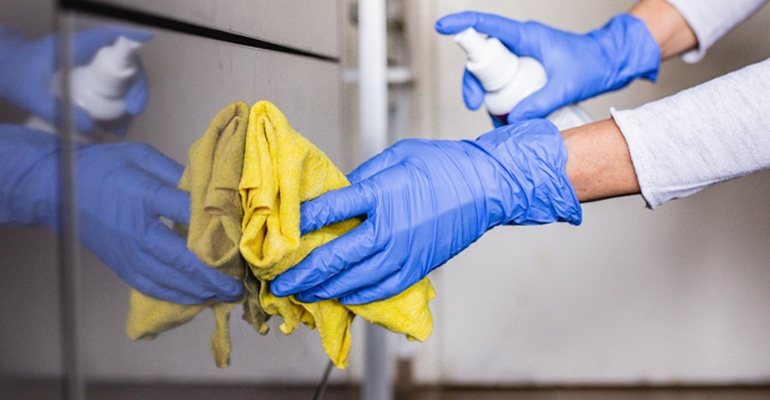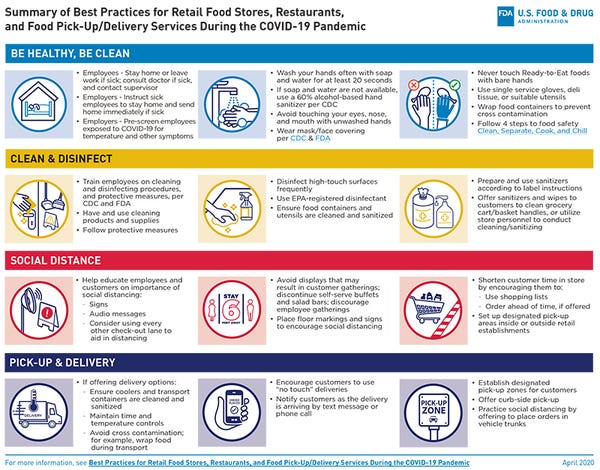You're trying to keep your business moving and your employees healthy. But are you ready if someone on your team gets sick?

Editor's note, April 13: Since this was published, the Food and Drug Administration has issued its guideline—Best practices for retail food stores, restaurants, and food pick-up/delivery services during the COVID-19 pandemic—which recommends implementing the workplace controls mentioned below, including screening employees before each shift; making employees wear masks; and practicing social distancing as much as possible. An infographic of these best practices can be downloaded here.
As COVID-19 continues to spread, it's time-consuming and difficult to keep up with directives from local, state and federal governments. Here's the latest information, from industry and federal sources, on what you need to do—and what you have to do—if an employee contracts coronavirus or develops COVID-19 symptoms.

Should you screen employees for COVID-19 symptoms or exposure?
Screening employees is a complicated process. Before you do anything, check federal, state and local laws to see what is allowed and what is not. You might even want to talk to a labor attorney, according to the guidance in Screening Food Industry Employees for COVID-19 Symptoms or Exposure. You also need to check employment contracts and collective bargaining agreements to see if they include restrictions on screening.
If your employees are working at home or away from other employees, you likely don't need to screen them—and you could face more legal questions if you try to implement it.
But if your employees are working in close contact with each other or members of the public, the need for screening increases. The federal Department of Labor, in its Guidance on Preparing Workplaces for COVID-19, advises on page 20 that jobs with a medium risk of exposure to COVID-19 "include those that require frequent and/or close contact with people who may be infected…but who are not known or suspected COVID-19 patients."
If the coronavirus is spreading quickly in your community, your employees might be more likely to contract it, so screening might be even more important, according to the food industry guidelines.
Remember, however, that employees who are not showing symptoms could still be infected with coronavirus.
What if an employee has symptoms or tests positive for COVID-19?
Jennifer McEntire, who holds a doctorate in food science from Rutgers University, is the vice president of food safety at United Fresh Produce Association. She and other colleagues worked together to create the Food Industry Recommended Protocols When Employee/Visitor/Customer Tests Positive for COVID-19.
Clearly, any employees who have tested positive for COVID-19 or has related symptoms such as fever, cough or shortness of breath should be sent home or prohibited from going to work.
Employees should stay home until they no longer have fevers, meaning their temperature is below 100.4 degrees Fahrenheit for at least 72 hours—without them using any fever-reducing or other medication such as cough suppressants—and seven days have passed since they first noticed the symptoms. Click here for a PDF of the Centers for Disease Control and Prevention's guidelines for people who might be ill.
If an employee lives with someone who is sick with COVID-19, the employee might need to stay home to care for that person, as noted on page 11 of the Department of Labor's publication. The CDC encourages employees in that situation to stay home and offers guidance for caretakers.
Do you have to provide paid sick leave or family leave during the pandemic?
The Families First Coronavirus Response Act requires some companies to provide two weeks' paid sick leave or emergency family leave until Dec. 31. All employees are eligible for up to 80 hours of paid leave—at 100% of their regular pay rate—if the employee is quarantined because of a government order or on the advice of a health care provider or if the employee has the symptoms of COVID-19.
If employees need to stay home to care for someone who is quarantined or take care of a child younger than 18 whose school is closed because of COVID-19-related reasons, all employees are eligible for up to 80 hours of leave and to receive two-thirds of their regular pay rate during that time. However, employees who have worked for the same company for at least 30 days are eligible for up to 10 more weeks (12 total) of paid leave at two-third of their regular pay rate.
Businesses with fewer than 50 employees might be exempt from the requirement to provide paid leave because schools are closed or childcare is unavailable. To qualify for the exemption, "the leave requirements would jeopardize the viability of the business as a going concern."
Private employers with fewer than 500 employees will receive tax credits for providing employees with COVID-19-related paid leave.
The Departmment of Labor has made attractive PDFs outlining the requirements on employers and employees' rights to paid leave.
What do you do at your facility if an employee has COVID-19 symptoms?
The Institute for Food Safety at Cornell University has developed downloadable checklists and documents to help food-related businesses plan for an employee becoming ill.
If no employees are ill, regular cleaning and sanitizing procedures will control contamination on food-contact surfaces, but high-risk locations such as restrooms, dining areas and frequently touched surfaces need to be cleaned, then sanitized.
Cornell has prepared a guide for employers if an employee is being tested for COVID-19, as well as what to if the test results are positive. As soon as the employer learns a staff member is being tested for COVID-19 or has symptoms that align with that illness, other workers should be informed that an individual is being tested. The ill employee's name must remain confidential, however.
All locations in your business will need to be cleaned and disinfected immediately, but others will have to be sanitized as well:
Food-contact surfaces
The outside of the employee's locker; the locker should remain locked.
The inside of every shared refrigerator. Throw out all food in a break room or shared refrigerator. The outside of the refrigerator should be cleaned and disinfected.
It's also important to reach out to employees who had close contact with the employee being tested. Although you have to maintain the ill employee's confidentiality, these other employees should be sent home, if possible.
If the employee tests positive for COVID-19 or develops all the symptoms that are typical of the disease, all surfaces need to be cleaned and disinfected again, and all food-contact surfaces must again be sanitized. Employers must contact the local health department of the employee's name, as well as the names of coworkers who were in close contact with the ill employee.
Employees who were sent home because they worked in close contact with the ill employee should continue to be quarantined or be tested for COVID-19.
The health department likely will have more information or directives for you to follow. The Cornell document has a thorough list of steps to take.
What other sources have COVID-19 information for employers?
Centers for Disease Control and Prevention
Food & Beverage Issue Alliance
Food and Drug Administration
The U.S. Department of Labor's Guidance on Preparing Workplaces for COVID-19
About the Author(s)
You May Also Like




